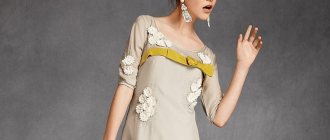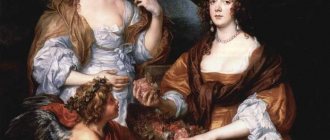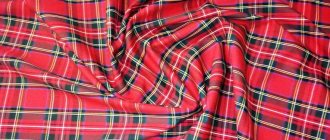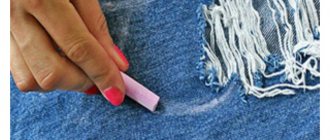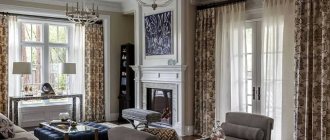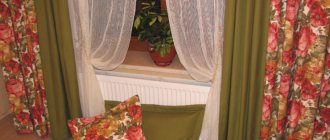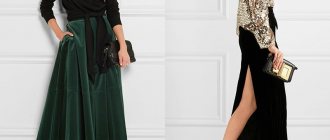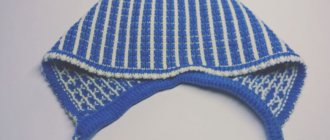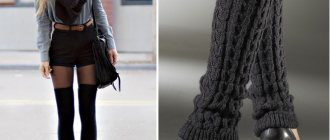Shuttlecocks open up unlimited possibilities for experimentation. One single element will help create many different looks.
In today's article we will look at a variety of conical designs - from peplum skirts to ruffled sleeves. The general rule is: the longer the outer length of the conical part, the more expressive the visual effect.
If you want to maximize the fluffiness, simply spread the sections of the piece further apart along the hemline or sew two “suns” together.
Sleeve with sun flounce
Shorten the dart along the elbow line by 1-2 cm.
Shorten the sleeve at the bottom by 12 cm.
Measure the width of the sleeve at the bottom (W).
Draw the inner circle of the flounce (= the cut of the stitching to the sleeve) with a radius of r = 0.16 x W = 0.16 x 31 cm = 4.96 cm.
From the inner circle, set aside vertically up and down, horizontally to the left and right, as well as along diagonal lines, the length of the shuttlecock equal to 12 cm (corresponding to the amount of shortening of the sleeve), and connect the resulting points, obtaining two squares, respectively.
Draw a line for the bottom of the shuttlecock as shown in the drawing.
What types of ruffles are there?
Frills are an interesting detail, but require a careful approach when choosing a specific solution.
Let's look at how you can decorate a dress with ruffles:
- ruffles on the shoulders - dresses of this cut allow you to demonstrate the beauty of a woman’s shoulders. An excellent solution for going to the cinema or a disco;
- ruffles on the chest are an ideal choice for women with small breasts. The model is almost universal in purpose;
- frills along the neckline are a spectacular solution that creates a festive look. They look especially elegant on dresses with an asymmetrical cut;
- flounces on the sleeves are a never-out-of-fashion solution. Such models are extremely popular all over the world;
- frill at the waist - a rather complex cut that creates unusual options;
- flounces at the back add piquancy and uniqueness to the look. Look great on ladies with large hips;
- flounces on the skirt - there are several options for placing frills at different heights. They all make dresses more magnificent and interesting. Dresses with frills on the skirt are often made for festive events and dances. This type of clothing is also suitable for everyday wear;
- vertical flounces – a model with such ruffles is perfect for women with small breasts;
- frills along the entire length of the dress are a stylish solution that adds femininity and sophistication.
Next, we’ll look at sewing some dress models.
Skirt with peplum-sun
Draw an inner circle (= upper edge of the peplum) with radius r = 0.16 x (OT measurement + 1.5 cm (loose fit allowance) + 2 cm (seam allowance)) = 0.16 x (76 cm + 1, 5 cm + 2 cm) = 12.7 cm.
Set aside the length of the peplum equal to 20 cm from the inner circle vertically up and down, horizontally left and right, as well as along diagonal lines, and connect the resulting points, getting two squares.
Set aside 2 cm from the sides of the squares. Draw a line for the bottom of the peplum through the resulting points, as shown in the drawing.
Preparatory stage: choosing fabric
Dresses decorated with flounces are made from various fabrics in structure and composition. If you plan to wear clothes in hot weather, then it is best to give preference to thin and light materials. It can be chiffon, chintz. For floor-length models, natural silk or satin is suitable. But for the cool season, we can recommend thin wool with elastic additives or soft knitwear. An outfit made of thin denim will look stylish and modern, which can be worn both in summer and warm autumn.
Advice! When sewing clothes with ruffles on the shoulders, you should consider the width of the frill. It should be no less than 5 cm. With the asymmetrical arrangement of the flounce on one shoulder (right or left - as is convenient and familiar to you), the dress model acquires a more sophisticated and romantic image.
Skirt with pleated flounce
Shorten the skirt by 15 cm (the length of the flounce).
Narrow the skirt details at the bottom line on the sides by 1.5 cm.
Separately measure the total length of the lower section of the front and back panels of the skirt.
Draw a vertical down and a horizontal to the right from point Z. Draw an arc of a circle with a center at point Z, radius r = (0.16 x Length of the lower section of the front of the skirt) x 4 = (0.16 x 48 cm) x 4 = 30.7 cm.
Set aside 15 cm horizontally - the length of the shuttlecock and through this point draw another arc of a circle with the center at point Z.
Draw cut lines on the shuttlecock (on one quarter, i.e. on the front of the shuttlecock) to create folds, as shown in the drawing. Cut the front part of the shuttlecock and spread the sections of the part by the allowances of the counter folds.
The folds on the back of the shuttlecock are done in the same way.
Required materials and tools
Before you start sewing, you need to choose a good material. First of all, it should keep its shape well, not stretch or shrink, not wrinkle, and also drape easily and form air waves. When choosing a material, special attention must be paid to ensure that they do not puff up and do not pull back the lining, but form smooth lines. Light denim, organza, chiffon, tulle and cotton are best suited for these purposes. For cold weather, it is best to give preference to suede, wool or plush.
Sewing tools
Note! When sewing a skirt, it is best to choose plain fabrics. They will effectively highlight the silhouette and demonstrate the sophistication of the cut. The flounces themselves carry a semantic load, so when combined with drawings and patterns they will look tasteless.
The set of accessories will depend on the model. Before sewing flounces on a dress, skirt or blouse, you need to prepare your tools. You will definitely need paper, scissors, chalk, a sewing machine, thread, needles, a ruler and a measuring tape.
Skirt with flowing drapery
The front panel of the skirt should be mirrored relative to the midline.
Draw a curved line for the bottom of the drapery from the bottom end of the left dart to the bottom line of the front panel of the skirt.
Draw three cut lines on the drapery in accordance with the drawing.
First move the drapery sections along the left cut line so that the sides of the dart are aligned. Along both remaining cut lines, separate the drapery sections by 10 cm, respectively.
Draw a new line for the top cut and bottom line of the drapery.
Fashionable colors
A dress with a wavy strip of fabric as decor can have any color.
Black
A sheath-shaped model or a fitted silhouette, straight, flared, made in black is an impeccable option for an evening outfit. The basque style looks very elegant.
Red
A bright red dress with flounce decoration is chosen by extraordinary and courageous women. This is a great option for creating an evening or formal look.
White
A snow-white dress with a decoration of one or several flounces is suitable for a romantic date, summer vacation, or a walk around the city. White color and wavy decorative elements are an indispensable attribute of a wedding dress.
Pink
An airy pink dress with drapery on the chest or hem is a model for young, romantic girls.
Skirt with spiral flounces
To determine the width of the flounce at the hem line, set aside 10 cm along the middle line of the back panel of the skirt.
From the resulting point, draw a line connecting the flounce with the panels of the skirt to the middle of the upper section of the front panel of the skirt.
Draw a vertical line and a horizontal line intersecting it.
Draw a circle with a center at the point of intersection of lines with radius r = 3 cm.
Starting from the inner circle, draw a shuttlecock counterclockwise, gradually increasing its width (the shuttlecock is drawn taking into account seam allowances of 1 cm on both sides).
Measure the length of the line connecting the flounce with the skirt and transfer the resulting value to the line of the top edge of the flounce.
Fabric selection
The choice of fabric is made depending on the type and functionality of the model. But it’s easy to decide on some details - a color or print that will suit and hide all the imperfections of the figure. If you take these features into account, it will be much easier to purchase the necessary textiles:
- For children, you should choose light, natural fabrics such as cotton or linen.
- Evening options should be made from noble fabrics - velvet, staples, butter.
- Summer models for women, girls and teenagers can be sewn from linen, silk, chiffon.
Note! It is worth choosing high-quality textiles, otherwise the finished product will look sloppy and quickly become unwearable.
Types of fabric for sewing dresses
Additionally, you will need accessories in the form of an elastic band, a hidden zipper or a button. You need to prepare the tools to do the job. It is worth taking scissors, measuring tape, chalk, paper, safety pins. Additionally, you will need a sewing machine.
Top with double cap sleeves
Measure the length of the front and back armhole line (Dpr).
Draw a vertical line and a horizontal line adjacent to it at right angles at point Z with radius r = (0.16 x DPR) x 2 = (0.16 x 46 cm) x 2 = 14.7 cm.
From the horizontal along the arc of the circle, set aside 12 cm upward (the length of the front part of the cap sleeve) and down 14 cm (the length of the back part of the cap sleeve).
To determine the length of the lower wing sleeve, set aside 10 cm to the right of the arc, and the upper wing sleeve - 8 cm.
Draw sections of both wing sleeves, as shown in the drawing.
Length
The dress, decorated with a wavy strip of fabric, can be of any length.
Long
A model that falls well below the knees with a cascade of flounces is suitable for slender and tall girls. The wavy stripe at the top of the long dress creates a romantic look. A fitted wedding dress with a flounce at the bottom is a popular style among brides.
A short
A short dress with ruffles at the bottom or at the waist is suitable for young and slender girls. Ruffles instead of sleeves or around the neckline add lightness and romance to the look.
The length is just below the knees - the choice of plump women and ladies over forty. At any age and with any figure, a woman should remain herself. Light ruffles at the hem of the dress or a flounce cape at the top are elegant details that highlight good taste.
Top with flounces in the form of corners
Widen the neckline of the product along the shoulder line by 2 cm, deepen it in the middle of the front by 19 cm.
Draw a seam line for the yoke on the front, into which the upper cut of the flounce will be sewn from the new neckline to the armhole, as shown in the drawing.
Measure the length of the front neckline from the yoke seam line to the middle of the front and the length of the yoke seam line from the neckline to the armhole.
Draw a shuttlecock in the form of a triangle with an angle of 110 degrees at its apex based on the obtained values. Thanks to this angle, a model excess length of approx. 8 cm required to obtain the tail of the shuttlecock. The larger the angle, the greater the amount of excess.
Features of the cut
Both shoulders can be considered open, with straps or with sleeves (sometimes the strap is made on only one). Often the flounces are made lowered: in this case, the top of the model will be a fragment of a bodice or blouse of a certain design.
The neck line of the product with one frill (gathered with an elastic band using a drawstring) flows into the shoulder line. Two pieces typically decorate the armhole circumference of a dress with a standard bodice design.
The pattern of a dress with a voluminous flounce implies a cut-off or one-piece design with a variable cut. The silhouette can be straight, fitted, flared, or even with a “sun” skirt. The length is variable - mini, midi, long, floor-length. Sometimes they are equipped with a drawstring at the waist, darts, and a belt.
This is interesting: Pattern Dress with raglan sleeves

